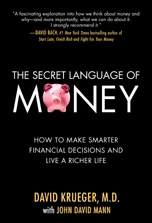
Professional Coaching for Healthcare Specialists
Writing the Next Chapter of Your Success Story
by David Krueger, MD
Professional Coaching Vignette
Leslie consulted me because she wanted to expand her clinical practice but felt stuck. She said she wanted either a Money Coach or a CEO Coach. An acknowledged expert in a niche area, she supervises the clinical practice of some therapists who work for her. Although she has a busy practice, she had income far below her recognized expertise.
We focused on her goals, and what she did uniquely well her primary passions. She completed my Needs, Ideals, and Concessions assessment tool to select the three needs and three ideals that best represented her core self. We immediately recognized a dicotomy between her wish to be taken care of, her need for autonomy and self-enhancement, and her ideals of mastery, creativity, and teaching others. Her needs and ideals conflicted, and were not in synchrony with her goals. She couldn’t get there from here, because all of her wasn’t going in the same direction.
Money resonated with emotional issues throughout most of Leslie’s life. She still held the hope that she would be nurtured in ways she felt she missed in childhood. For Leslie’s busy professional parents, money served as proxy for love and availability tangible evidence that they cared for her. To make substantial money now meant she would give up her wish of being taken care of by someone else: the ghost of the old story, still hungry. Success and money accumulation would mean Leslie was taking care of herself, which she wanted. But then the fantasy dies. The impossible had become accessible, though now by her own efforts.
We examined four arenas of her practice: what she wanted to change, exclude, avoid, and enhance. She refined her vision, established SMART goals (Specific, Measurable, Attainable, Relevant, and Time-bound. She fashioned three initiatives for each goal. Our collaboration focused on specific strategies to navigate change.
One result of our work was that Leslie happily expanded what she did uniquely well consulting with individuals and families. We also found a way to strategically leverage her time and income by licensing people in her program; she franchised a component of her business to a national group for significant royalty income.
The Scope and Roles of Professional Coaching
Healthcare professionals or executives encounter issues that require awareness of emotional intelligence, motivation, behavior, and how people succeed. Their navigation of these matters influences many people inside and outside a system.
Certain human needs are universal, and remain present throughout life: emotional connection, effectiveness, and intellectual stimulation. These needs have even more valence with increased demands, at times of change, and with stressful challenges. Professional Coaching addresses these needs with a new delivery system for mentorship, accountability, partnership, and co-creative work.
As a Professional Coach, I help people write the next chapters in their business stories: what’s next, how to get there, and how to succeed at what happens after what happens next. My clients develop their success skills by learning more about themselves, human dynamics, and systems.
At various times with each client I am guide, strategist, empathic listener, Dutch uncle, teacher, and collaborator. And we do many things together: engage visible obstacles to visualize possibilities, align vision with needs and ideals, reframe concerns into possibilities, move fears into intentions, and co-create options.
This confidential collaboration, usually done by weekly telephone appointments, addresses core aspects of growth. Our work usually centers on common themes:
- Maximize performance and emotional rewards
- Enhance financial return
- Expand a career or business story
- Articulate a powerful personal vision that will inspire others
- Navigate major transitions
- Catalyze necessary change and reinvention
- Expand emotional intelligence of people and systems
In a Harvard study begun in the mid-1950’s, 10-15% of the Harvard Business School graduates fashioned a specific vision for their life in business. Five decades later, those 10-15% had 90% of the assets of the entire group.
The Lore Institute found that about 80% of large companies use Executive Coaches to develop leadership, enhance emotional intelligence, and ensure success at times of significant transition. Three recent business impact studies demonstrated an average of a six-fold return on investment for money spent on Executive Coaching.
How Do You Co-Create a New Story?
Stories are how we understand and how and how we remember. Our plot–our core beliefs and assumptions—informs what we notice and how we process experience. We then create narratives according to that plot. A story holds together facts, and relates information.
We ignore facts that contradict what we believe. We see only what fits a recognizable pattern on our personal radar. We believe not as much what we want to believe but what we expect to believe. Our brains and emotions are both programmed this way. We believe according to our self-image. Our views are self- statements of our perception. We also use logic and reason after the fact to rationalize emotion-based experiences. Although we see ourselves as principled, logical and objective in sorting through the facts, research demonstrates that we make decisions based on emotion, colored by bias and belief.
We see what we believe.
People see what they look for, and want to make sense of what they see. And what they look for—what appears on the radar screen—is determined by belief and assumption. For example, the most common reason people don’t earn more money and accumulate wealth is that they don’t see themselves capable of it. Once someone genuinely sees himself or herself as capable of doing it, all sorts of thing begin to happen.
The seminar room was packed with marketing executives who came to hear coaching on how to create their hottest market tool: their own book. I stepped to the podium and asked, “Have any of you seen a yellow jeep in the last month?” They registered disbelief, and finally puzzlement as they realized I was waiting for a response to a legitimate question. Finally one person tentatively raised his hand, as though he were still questioning either my seriousness or his memory.
I told them they could see a yellow jeep, now, if they wanted to. I asked them to close their eyes and visualize a yellow jeep, the specific detail of how it looked from different angles, how it felt when they touched it, how the interior smelled.
I asked them to open their eyes, and to call or email me if they happened to spot a yellow jeep. Almost everyone contacted me to report their first sighting in the following week– most in the first two days.
The number of yellow jeeps—or wealth—existing in the world doesn’t change, you just code your radar for possibility. You become what you think and feel. Beliefs become reality.
A farmer and an anthropologist pass through the same terrain of undeveloped land. The farmer sees the soil and envisions growing crops. The anthropologist sees signs of an ancient civilization and reconstructs its history. Both are right. The data viewed validates each individual’s story.
Using beliefs and assumptions, you create your own personal story and the themes of that story. The plot that you create defines and orients you in the present and guides you toward the future. The stories you tell about your life becomes your life.
Similarly, internal beliefs determine perceptions, including how you select, register and process everything you encounter.
Scientists went to a lot of trouble to discover what mothers have always known about banishing closet monsters that a placebo generates the effect of the accompanying story. The inert pill is really a story of expectation, taking the form of a medicine to work its magic. The patient is also prescribed some expectations, and in the majority of cases, they manifest. The effect validates the power of story. The story generates a truth so powerful that it can even reverse the pharmacological effect of a real medicine. The placebo is a white lie, a fiction that creates a truth. This effect shows that someone can create an experience by anticipating it.
Your experiences are always consistent with your assumptions.
Change begins with the recognition that you are the author of your own story. People perceive and remember what fits into their personal plot–an internal model of oneself and the world. Beliefs and assumptions dictate what you look for, and attribute meaning. You always find or create that which validates those beliefs, and ignore, mistrust, disbelieve–or more likely don’t notice–anything that doesn’t fit into that pattern.
The best way to escape an ongoing problem is not to create it.
Recognizing constraint and limitation, coupled with the desire to change, may give rise to the question, “How do I get out of the story?” The question assumes the story is there, a given in the universe. The story (the proverbial “box” of the familiar and accepted) becomes the obstacle, yet it is not there until created. To recognize yourself as the author–the creator of the story–challenges an assumed model, usually your own. The question may then become “How do I create something else instead?”
Creating a plan and plotting a course allows you to stay on track, recognize and avoid detours and tangents, and move more effectively toward goals. Without a plan, you can’t know where you are, and cannot strategize to get to where you want to go. If you don’t know where you want to go (a goal), you can’t figure out how to get there.
People are always free to change their minds, always free to change beliefs and core assumptions.
Change references the past. Transformation creates a new present and future. To stop doing something is not complete change–a new story incorporates new behavior and beliefs. New theory does not supplant old story. You have to embody–actually live–the story you want. Abstaining from an old story–such as symptomatic eating–is a beginning.
You have to have a new story to be in before you can give up an old story.
To become a hero of your own story, to become your own authority, requires establishing an internal ideal and living up to it. Plot is what your hero does; bad writing is making your hero do things to fit into the plot; ghostwriting is fitting into someone else’s plot.

Business Bestseller
Translated into 10 Languages
Author Geneen Roth lost everything to Bernie Madoff. Read her comments about The Secret Language of Money.
http://bit.ly/e5Ipph
